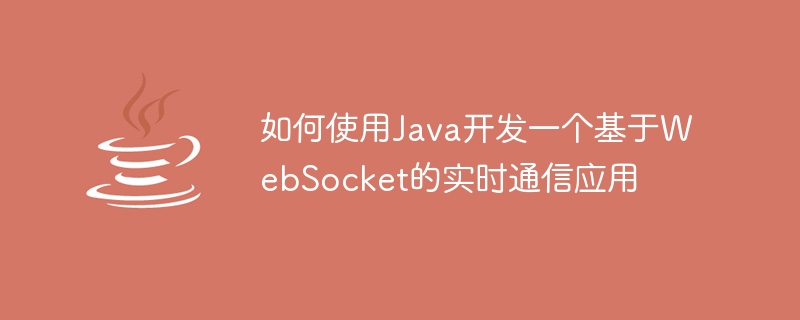

How to use Java to develop a real-time communication application based on WebSocket
In modern Web applications, real-time communication has become a necessary function. WebSocket technology plays an important role in this regard. WebSocket is a full-duplex communication protocol that allows real-time two-way communication between the server and client. This article will introduce how to use Java to develop a real-time communication application based on WebSocket, and provide some specific code examples.
Before we start, we need to prepare some tools and environment:
First, we need to create a new Maven project. In your IDE, choose to create a new Maven project and fill in the relevant information, such as GroupId, ArtifactId, etc. Once created, you will get a basic Maven project structure.
We need to add some dependencies to support WebSocket functionality. In the project's pom.xml file, add the following dependencies:
<dependencies>
<dependency>
<groupId>org.springframework.boot</groupId>
<artifactId>spring-boot-starter-websocket</artifactId>
</dependency>
</dependencies>Here we use Spring Boot's WebSocket starter to simplify configuration and use.
In the src/main/java directory of the project, create a package named com.example.websocket. Create a class named WebSocketApplication under the package and add a main method:
package com.example.websocket;
import org.springframework.boot.SpringApplication;
import org.springframework.boot.autoconfigure.SpringBootApplication;
@SpringBootApplication
public class WebSocketApplication {
public static void main(String[] args) {
SpringApplication.run(WebSocketApplication.class, args);
}
}This class is the entry point of the application, and the application is started by running the main method.
Next, we create a WebSocketConfig class to configure WebSocket.
package com.example.websocket;
import org.springframework.context.annotation.Configuration;
import org.springframework.web.socket.config.annotation.EnableWebSocket;
import org.springframework.web.socket.config.annotation.WebSocketConfigurer;
import org.springframework.web.socket.config.annotation.WebSocketHandlerRegistry;
@Configuration
@EnableWebSocket
public class WebSocketConfig implements WebSocketConfigurer {
@Override
public void registerWebSocketHandlers(WebSocketHandlerRegistry registry) {
registry.addHandler(new WebSocketHandler(), "/ws").setAllowedOrigins("*");
}
}In this class, we use the @Configuration annotation to mark this as a configuration class, and use the @EnableWebSocket annotation to enable WebSocket support. Next, we implement the WebSocketConfigurer interface and override the registerWebSocketHandlers method to configure the WebSocket processor. Here, we registered a handler named WebSocketHandler and specified the access path as /ws, allowing all sources to connect.
Finally, we create a WebSocketHandler class to handle WebSocket connections and messages:
package com.example.websocket;
import org.springframework.web.socket.TextMessage;
import org.springframework.web.socket.WebSocketSession;
import org.springframework.web.socket.handler.TextWebSocketHandler;
public class WebSocketHandler extends TextWebSocketHandler {
@Override
protected void handleTextMessage(WebSocketSession session, TextMessage message) throws Exception {
String payload = message.getPayload();
// 处理收到的消息
session.sendMessage(new TextMessage("Hello, " + payload));
}
}In this processor class, we inherit TextWebSocketHandler and override the handleTextMessage method to handle the received Text message. Here we simply add a prefix to the received message and send it back to the client.
Now, we have finished writing the code. Next, we run the application to test the functionality of WebSocket.
In your IDE, click the Run button to start the application. When the application starts successfully, you can visit http://localhost:8080 to open the application's homepage. In the browser's developer tools, open the console and you will see an output similar to the following:
WebSocket connection to 'ws://localhost:8080/ws' initialized
This means that you have successfully established a connection with the WebSocket server.
Now, you can enter a piece of text in the console, such as "Alice", and then press Enter. You will see an output similar to the following:
Hello, Alice
This indicates that you successfully sent a message and received a response from the server.
So far, we have completed the introduction on how to use Java to develop a real-time communication application based on WebSocket. Hope this article helps you!
The above is the detailed content of How to use Java to develop a real-time communication application based on WebSocket. For more information, please follow other related articles on the PHP Chinese website!




